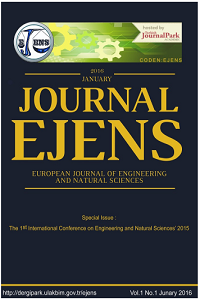Evaluation of Commercial Type of Split Air Conditions by Using Condenser Waste Heat in a Boiler
Evaluation of Commercial Type of Split Air Conditions by Using Condenser Waste Heat in a Boiler
condenser,
___
- T. Menlik, A. Demircioğlu, and M.G. Özkaya, “Energy and Exergy Analyses of R22 and its Alternatives R407c and R410a in a Vapor Compression Refrigeration System”, Journal of Exergy, vol. 12 (1), pp. 11-30, 2013.
- R. Saidur, H.H. Masjuki and M.Y. Jamaluddin, “An application of energy and exergy analysis in residential sector of Malaysia”, Energy Policy, vol. 35, pp. 1050–1063, 2007
- [A. Ergün, T. Menlik, T. and M.G. Özkaya, “Energy and Exergy Analyses of the Heating System in a Multipurpose Building”, Gazi Journal of Engineering Science, vol. 1, pp. 195-218, 2015.
- A. Ergün, T. Menlik, T. and M.G. Özkaya, “First and Second Law Analysis of Central Cooling System of a Multipurpose Buildings”, International Symposium on Innovative Technologies in Engineering and Science, vol. 12(A) pp. 1974-1983, Karabuk Turkey. 2014.
- A. Ergün, “Energy and Exergy Analyses of a Shopping Center Which Needs 80.000 M2 Heating and Cooling”, Master Thesis, Gazi University Graduate School of Natural and Applied Sciences, Ankara, 2010.
- P. Martínez, J. Ruiz, C.G. Cutillas, P.J. Martínez, A.S. Kaiser and M. Lucas, “Experimental study on energy performance of a split air-conditioner by using variable thickness evaporative cooling pads coupled to the condenser”, Applied Thermal Engineering, In press (doi: 10.1016/j.applthermaleng.2016.01.06.) 2016.
- K. Sumeru, S. Sulaimon, H. Nasution and F. N. Ani, “Numerical and experimental study of an ejector as an expansion device in split-type air conditioner for energy savings”, Energy and Buildings, vol. 79, pp. 98–105. 2014.
- A. S. Padalkar, K.V. Mali and S. Devotta, “Simulated and experimental performance of split packaged air conditioner using refrigerant HC-290 as a substitute for HCFC-22”, Applied Thermal Engineering, vol. 62, pp. 277-284, 2014.
- D. Kumlutas¸ Z. H. Karadeniz and F. Kuru, “Investigation of flow and heat transfer for a split air conditioner indoor unit”, Applied Thermal Engineering, vol. 51 pp. 262-272, 2013.
- J. Jia and W.L. Lee, “Experimental investigations on the use of capillary tube and thermostatic expansion valve in storage-enhanced heat recovery room air-conditioner”, Energy and Buildings, vol. 101, pp. 76–83, 2013.
- J. Jia and W.L. Lee, “Experimental investigations on using phase change material for performance improvement of storage-enhanced heat recovery room air-conditioner”, Energy, vol. 93 pp. 1394-1403, 2015.
- Başlangıç: 2015
- Yayıncı: CNR Çevre
Prediction of Dam Reservoir Volume Fluctuations Using Adaptive Neuro Fuzzy Approach
Process Design for the Recycling Of Tetra Pak Components
Evaluation of Commercial Type of Split Air Conditions by Using Condenser Waste Heat in a Boiler
Isotherm and Kinetic Modelling of Azo Dyes Adsorption
Tribological Properties of Boron Carbide Reinforced Copper Based Composites
